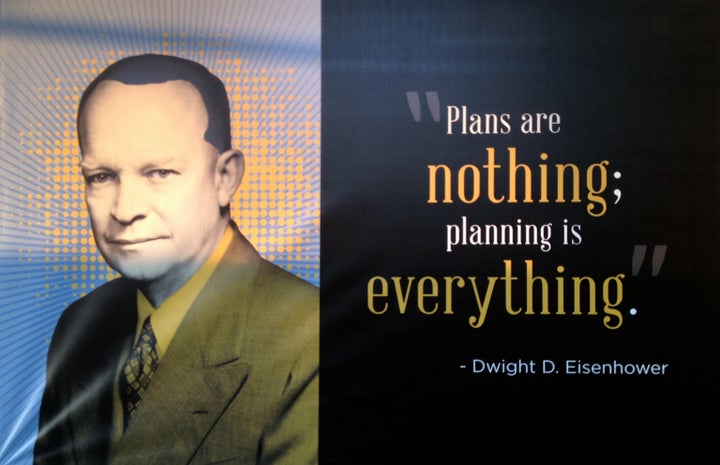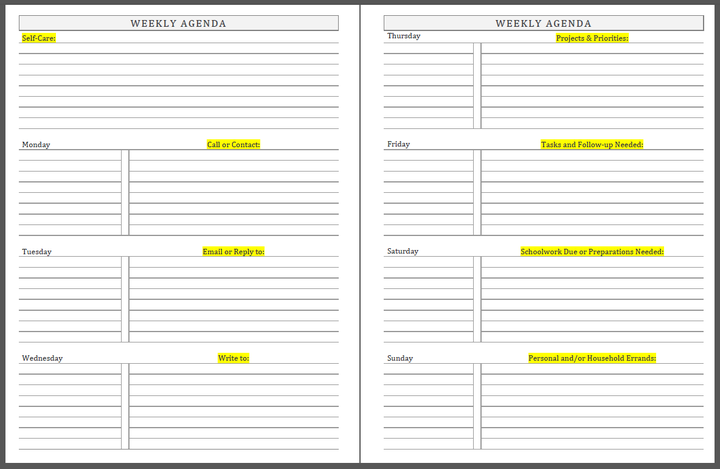
A hanging banner covering construction in downtown Washington, DC several years ago, part of a series.
A man who gave some thought to winning a few battles and blasting through a few goals in his life, President Dwight D. Eisenhower, had it right: “Plans are nothing,” he said, but the process of planning is “everything.”
As human beings, we often feel plagued by a nagging sense that we could be getting more out of life — accomplishing more in our personal or professional lives, at work or at school — if only we were more or better organized. Personal planners are a key tool we use to pursue that goal, and they’ve come a long way since the Old Skool days of hastily scrawled lists on scrap paper, or even using one of the most popular planners for decades, DayTimer, DayRunner, or the Franklin planner system, now part of Franklin Covey.
Long before their association Stephen Covey, author of the organizational classic, “The 7 Habits of Highly Effective People,” the Franklin planner’s sensible prioritization scheme — A for vital, B for important, and C for “nice” (or fairly forgettable) — along with the insistence that daily tasks be linked to larger life goals made a lot of sense to users, many of whom had decades of binders on their shelves, testifying to their long-term use. Franklin also offered in-person trainings that helped users establish and reinforce good organizational habits.
Fast forward to the Internet, and suddenly choices for personal planning systems enlarged to include digital options, and then with the advent of smartphones, mobile applications. All of which means that choosing a planner today means selecting from an almost dizzying array of choices, both digital and paper. The trouble is, though, it’s not like finding our favorite beverage at Starbucks and being able to reliably order it every time. Some of us are literally stuck in planner limbo — knowing what we want to accomplish, but not having a firm sense of what will get us there. In dating parlance, we have not found “the one.” We are on Planner Tindr, continuing to swipe right, hoping for a match.
It was with that dilemma in mind that I reached out to my Facebook feed. “Hive mind,” I wanted to know, “If you consider yourself an organized person, what planner are you currently using, and are you happy with it?” “Ritalin and a notebook” was the wittiest response, as friends and colleagues offered up umpteen possible suggestions. The names were pretty evocative as well — everything from “bullet” to “self” to “panda” to “passion” (Yes, those are all actual names of planners.)
On the digital side, it’s easier to see consensus. Many people are using, and are happy with, Google’s Gmail calendar, although a number of people are still using Outlook, usually for work. Being able to sync your contacts and calendar from your mobile device to your laptop or desktop, and vice-versa, is a very useful asset. I’ve been using the wireless over-the-air sync for years, and it’s both excellent and essentially problem-free. (Google “wireless over-the-air sync” for instructions for your device.) Omnifocus was also mentioned as a fairly all-encompassing digital system.
Cognitive Processing
But on the paper side, there are still a number of options — as well as quite a few reasons people still want to connect with the experience of physically touching pen or pencil to paper, to sketch out tasks or move them forward. It may even be that there’s some different aspect of the process or our brains that’s engaged when we do so, similar to the finding that taking handwritten notes in class may be more beneficial than taking them on a computer. I absolutely love mind-mapping, a project management skill I learned years ago in a Franklin Covey course, and while it can be done with software, I don’t find I enjoy the process as much, or more importantly seem to benefit from it as deeply, as when I pull out a quadrille pad or a whiteboard and map out a topic.
This brings up an issue with why it may take us a while to actually “find” the perfect system for us. When we focus on just what we want to accomplish, we may think that any old road (erm, planner) will get us there. But if we factor in how we like to experience the process, we could really optimize our chances for success.
And this gets back to the “Ritalin and a calendar” comment, which while funny, has quite a grain of truth in it. If your interest in organizing is limited to just keeping track of items on a To-Do list and checking them off as they’re done, almost any tool will get you there and it’s more a question of choosing your favorite format, most likely in a mobile app. But if your planning emphasizes process, you’ll quickly find yourself limited by an essentially task-based format and ultimately wanting more.
Into the gap comes an array of planning systems in both bound versions and printable PDF formats. Remarkably, a number of them come with free downloads or trial versions you can try before you buy — along with, in many cases, training videos and online user communities to reinforce enthusiasm or share various hacks. There’s a whole range too from relatively “get it done” type systems to ones that emphasize a more holistic sense of life satisfaction and its correlates.
A few key selections that bubbled to the top, all with satisfied users (arrayed in alphabetical order):
- Bullet Journal;
- Holistic Life Planner (printable downloads);
- Momentum Planners from Productive Flourishing. Bound versions, but also many free downloads, including daily, weekly and monthly planner pages; and specific task accomplishment templates.
- Panda Planner;
- Passion Planner (various sizes, dated and undated versions, including academic versions, bound and printable PDFs);
- Planner Pads (various sizes, dated and undated versions, including academic versions, bound and printable PDFs);
- Rituals for Living Dreambook (dated and undated versions, bound and printable PDFs);
- Self Journal;
- Topdown Planners (bound versions and printable downloads);
A colleague who has shared her experience with adult ADHD took the planning concept one step farther when she casually mentioned what she thinks holds her back is the lack of 3D modeling that task planning implies. She not only wants to see her tasks — like those models students make of molecules in organic chemistry, she actually wants to see how her tasks look in space and time. What’s hiding under what? What direction is each task moving in? I can appreciate her dilemma. It’s part of the limitation of lists to start with — once too many tasks pile up, with no sense of their relative importance, it all starts to look like one of those extremely busy menus from a Chinese restaurant that wants to list all 128 of its menu items. It’s hard not to go into shutdown mode, when each choice seems equally weighted.

The caffeine molecule in 3D by Jynto (Wikipedia).
This brings up a related concept, which is how do those with ADD or ADHD experience time, how does it impact their ability to plan, and would it result in any key adjustments to what planning systems work best for them? It turns out there’s already a lot of great material on this subject — plus, as you can imagine by now, some planners specifically designed for adults with these different abilities. Several of the best items I found in my search:
- A post about various planners for ADD/ADHD and their pros and cons;
- A discussion about how combining daily and weekly planners may work best;
- A discussion from an ADD/ADHD site about using planners to stay on track;
- Three adults with ADD/ADHD but different planning needs and challenges discuss how well their solutions worked; and
- A fab article about 15 mobile apps that help keep ADD/ADHDers on track, but also enhance various time- and personal-management goals — including rest and relaxation.
By the time I finished my deep dive into this “research,” including downloads and trials of various planning systems, I came to the sorry but inescapable conclusion that I still hadn’t found “the one,” and needed to keep on planner-dating. The articles on ADHD and planning helped clarify my resistance to choosing a single system, and the understanding that a daily and a weekly planner, running simultaneously as it were, were probably the best idea still left me overwhelmed. Maybe it’s an occupational hazard of being an INTJ — we overthink, but also optimize everything, and we DO think of that as an asset — but now that I knew more, I was starting to understand why I couldn’t be happy with any one system unless — scary thought — I designed it myself, customizing it to my exact needs. I have lots of systems that are already working — Google calendar for events, iPhone notes for shopping lists and general notes. I use dictation heavily and it’s totally a productivity hack. But, for what I want — and I know what I want, I just haven’t been able to find it — maybe I just need to build it myself.

This is pretty plain Vanilla, but I like that it reflects what I’m actually trying to get done in a week — and not accidentally drop.
In other words, why not Google “DIY Planner” in the middle of the night, as obsessed insomniac perfectionists are wont to do, and find that there’s a whole robust forum tailored to people who come to this exact fork in the road. And these people, we might want to call them “our tribe,” have kindly uploaded free templates they’ve designed in a searchable forum located here: D*I*Y planner. We can use the provided templates either as-is or download and customize them ourselves. Many are provided with descriptions by their developers about what problems they were looking to solve, which makes them even more useful.
The upshot to my own situation was, I ended up searching the forum, downloading a few templates, customizing the closest one to what I felt like I needed, and printing it out for use. Turns out, it completely met my needs — and as I work with it for the next few weeks, “test-driving” it, I can continue to customize it to what I want. The ultimate test for any planning system is really two part: does it help you to make progress on your important, not non-essential goals; and does it motivate you to actually use it? If any planner you can find passes those tests, you’re on your way to much greater accomplishment. Kudos.
